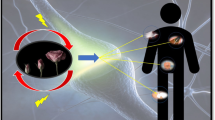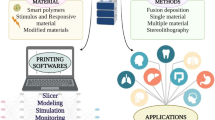Abstract
Shape memory polymers are smart materials that produce shape changes under external stimulus conditions. Four-dimensional (4D) printing is a comprehensive technology originate from deformable materials and three-dimensional (3D) printing technology. At present, 4D printed shape memory polymers and shape-changing structures have been applied in various fields, especially in the field of biomedical science. 4D printing technology has made a breakthrough of personalized customization in the traditional medical field, providing a new direction for the further development of the biomedical field. In this review, the recent research and development of shape memory polymer, 3D printing technology, 4D printed shape memory polymers and shape-changing structures in biomedical area are present. The examples and applications of 4D printed shape memory polymers and their structures in the area of biomedical are also introduced. Based on 4D printing, stimulated by different conditions, 3D printed objects can be fabricated into various biomedical applications such as cell scaffolds, vascular stents, bone scaffolds, tracheal stents and cardiac stents by different 3D printing techniques. Finally, the application prospects, existing technical restriction and future development directions of 4D printed shape memory polymers and their structures in the biomedical field are summarized.
Similar content being viewed by others
References
Lan X, Liu Y, Lv H, et al. Fiber reinforced shape-memory polymer composite and its application in a deployable hinge. Smart Mater Struct, 2009, 18: 024002
Rodriguez J N, Zhu C, Duoss E B, et al. Shape-morphing composites with designed micro-architectures. Sci Rep, 2016, 6: 27933
Zhao Q, Qi H J, Xie T. Recent progress in shape memory polymer: New behavior, enabling materials, and mechanistic understanding. Prog Polym Sci, 2015, 49–50: 79–120
Wei H Q, Wan X, Liu Y J, et al. 4D printing of shape memory polymers: Research status and application prospects (in Chinese). Sci Sin Tech, 2018, 48: 2–16
Behl M, Lendlein A. Shape-memory polymers. Mater Today, 2007, 10: 20–28
Hu J, Zhu Y, Huang H, et al. Recent advances in shape-memory polymers: Structure, mechanism, functionality, modeling and applications. Prog Polym Sci, 2012, 37: 1720–1763
Leng J, Lan X, Liu Y, et al. Shape memory polymers composites and their applications in deployable structures (in Chinese). J Astronaut, 2010, 4: 950–956
Momeni F, Ni J. Nature-inspired smart solar concentrators by 4D printing. Renew Energy, 2018, 122: 35–44
Lendlein A, Langer R. Biodegradable, elastic shape-memory polymers for potential biomedical applications. Science, 2002, 296: 1673–1676
Hardy J G, Palma M, Wind S J, et al. Responsive biomaterials: Ad vances in materials based on shape-memory polymers. Adv Mater, 2016, 28: 5717–5724
Lendlein A, Kelch S. Shape-memory polymers as stimuli-sensitive implant materials. Clin Hemorheol Micro, 2005, 32: 105–116
Tibbits S. Printing products. 3D Print Add Manuf, 2016, 3: 135
Tibbits S. 4D Printing: Multi-material shape change. Archit Des, 2014, 84: 116–121
Leng J, Lan X, Liu Y, et al. Shape-memory polymers and their composites: Stimulus methods and applications. Prog Mater Sci, 2011, 56: 1077–1135
Momeni F, Hassani N S M, Liu X, et al. A review of 4D printing. Mater Des, 2017, 122: 42–79
Leist S K, Zhou J. Current status of 4D printing technology and the potential of light-reactive smart materials as 4D printable materials. Virtual Phys Prototyping, 2016, 11: 249–262
Khoo Z X, Teoh J E M, Liu Y, et al. 3D printing of smart materials: A review on recent progresses in 4D printing. Virtual Phys Prototyping, 2015, 10: 103–122
Shin D G, Kim T H, Kim D E. Review of 4D printing materials and their properties. Int J Precis Eng Manuf-Green Tech, 2017, 4: 349–357
Ge Q, Sakhaei A H, Lee H, et al. Multimaterial 4D printing with tailorable shape memory polymers. Sci Rep, 2016, 6: 31110
Lee A Y, An J, Chua C K. Two-way 4D printing: A review on the reversibility of 3D-printed shape memory materials. Engineering, 2017, 3: 663–674
Bodaghi M, Damanpack A R, Liao W H. Adaptive metamaterials by functionally graded 4D printing. Mater Des, 2017, 135: 26–36
Choi J, Kwon O C, Jo W, et al. 4D printing technology: A review. 3D Print Add Manuf, 2015, 2: 159–167
Wei H, Zhang Q, Yao Y, et al. Direct-write fabrication of 4D active shape-changing structures based on a shape memory polymer and its nanocomposite. ACS Appl Mater Interfaces, 2017, 9: 876–883
Zhang F, Wang L, Zheng Z, et al. Magnetic programming of 4D printed shape memory composite structures. Compos Part A-Appl Sci Manufacturing, 2019, 125: 105571
Bodaghi M, Damanpack A R, Liao W H. Triple shape memory polymers by 4D printing. Smart Mater Struct, 2018, 27: 065010
Ly S T, Kim J Y. 4D printing-fused deposition modeling printing with thermal-responsive shape memory polymers. Int J Precis Eng Manuf-Green Tech, 2017, 4: 267–272
Yang Y, Chen Y, Wei Y, et al. 3D printing of shape memory polymer for functional part fabrication. Int J Adv Manuf Tech, 2016, 84: 2079–2095
Miao S, Castro N, Nowicki M, et al. 4D printing of polymeric materials for tissue and organ regeneration. Mater Today, 2017, 20: 577–591
Huang L, Jiang R, Wu J, et al. Ultrafast digital printing toward 4D shape changing materials. Adv Mater, 2017, 29: 1605390
Li X, Shang J, Wang Z. Intelligent materials: A review of applications in 4D printing. Assembly Automation, 2017, 37: 170–185
Pei E. 4D printing: Dawn of an emerging technology cycle. Assembly Automation, 2014, 34: 310–314
Choong Y Y C, Maleksaeedi S, Eng H, et al. 4D printing of high performance shape memory polymer using stereolithography. Mater Des, 2017, 126: 219–225
Bito J, Bahr R, Hester J, et al. Inkjet-/3D-/4D-printed autonomous wearable RF modules for biomonitoring, positioning and sensing applications. In: Proceedings of Micro- and Nanotechnology Sensors, Systems, and Applications IX. Anaheim: SPIE, 2018
Monzón M D, Paz R, Pei E, et al. 4D printing: Processability and measurement of recovery force in shape memory polymers. Int J Adv Manuf Technol, 2017, 89: 1827–1836
Naficy S, Gately R, Gorkin Iii R, et al. 4D printing of reversible shape morphing hydrogel structures. Macromol Mater Eng, 2017, 302: 1600212
Wan X, Wei H, Zhang F, et al. 3D printing of shape memory poly(d,l-lactide-co-trimethylene carbonate) by direct ink writing for shape-changing structures. J Appl Polym Sci, 2019, 136: 48177
Kim K, Zhu W, Qu X, et al. 3D optical printing of piezoelectric nanoparticle-polymer composite materials. ACS Nano, 2014, 8: 9799–9806
Mu Q, Dunn C K, Wang L, et al. Thermal cure effects on electromechanical properties of conductive wires by direct ink write for 4D printing and soft machines. Smart Mater Struct, 2017, 26: 045008
Yoon C K, Xiao R, Park J H, et al. Functional stimuli responsive hydrogel devices by self-folding. Smart Mater Struct, 2014, 23: 094008
Leong T G, Randall C L, Benson B R, et al. Tetherless thermo-biochemically actuated microgrippers. Proc Natl Acad Sci USA, 2009, 106: 703–708
Gall K, Mikulas M, Munshi N A, et al. Carbon fiber reinforced shape memory polymer composites. J Intelligent Material Syst Struct, 2000, 11: 877–886
Wu W, You Z. A solution for folding rigid tall shopping bags. Proc R Soc A, 2011, 467: 2561–2574
Myers B, Bernardi M, Grossman J C. Three-dimensional photovoltaics. Appl Phys Lett, 2010, 96: 071902
Guo X, Li H, Yeop Ahn B, et al. Two- and three-dimensional folding of thin film single-crystalline silicon for photovoltaic power applications. Proc Natl Acad Sci USA, 2009, 106: 20149–20154
Small, IV W, Singhal P, Wilson T S, et al. Biomedical applications of thermally activated shape memory polymers. J Mater Chem, 2010, 20: 3356–3366
Zhu W, Cui H, Guo D, et al. Properties and biomedical applications of shape memory polymers (in Chinese). Chin J Tissue Eng Res, 2014, 18: 7677–7682
Miao S, Zhu W, Castro N J, et al. 4D printing smart biomedical scaffolds with novel soybean oil epoxidized acrylate. Sci Rep, 2016, 6: 27226
Hendrikson W J, Rouwkema J, Clementi F, et al. Towards 4D printed scaffolds for tissue engineering: Exploiting 3D shape memory polymers to deliver time-controlled stimulus on cultured cells. Biofabrication, 2017, 9: 031001
Miao S, Zhu W, Castro N J, et al. Four-dimensional printing hierarchy scaffolds with highly biocompatible smart polymers for tissue engineering applications. Tissue Eng Part C-Methods, 2016, 22: 952–963
Hsiao S H, Hsu S. Synthesis and characterization of dual stimulisensitive biodegradable polyurethane soft hydrogels for 3D cell-laden bioprinting. ACS Appl Mater Interfaces, 2018, 10: 29273–29287
Zarek M, Mansour N, Shapira S, et al. 4D printing of shape memory-based personalized endoluminal medical devices. Macromol Rapid Commun, 2017, 38: 1600628
Meyer W, Engelhardt S, Novosel E, et al. Soft polymers for building up small and smallest blood supplying systems by stereolithography. JFB, 2012, 3: 257–268
Wu Z, Zhao J, Wu W, et al. Radial compressive property and the proof-of-concept study for realizing self-expansion of 3D printing polylactic acid vascular stents with negative Poisson’s ratio structure. Materials, 2018, 11: 1357
Morrison R J, Hollister S J, Niedner M F, et al. Mitigation of tra-cheobronchomalacia with 3D-printed personalized medical devices in pediatric patients. Sci Transl Med, 2015, 7: 285ra64
Zhao W, Zhang F, Leng J, et al. Personalized 4D printing of bioin-spired tracheal scaffold concept based on magnetic stimulated shape memory composites. Compos Sci Tech, 2019, 184: 107866
Wang Y, Wang F, Wang Z, et al. Research progress and application perspectives of 4D printing (in Chinese). J Aeronaut Mater, 2018, 38: 70–76
Zhou Y, Huang W M, Kang S F, et al. From 3D to 4D printing: Approaches and typical applications. J Mech Sci Tech, 2015, 29: 4281–4288
Sydney Gladman A, Matsumoto E A, Nuzzo R G, et al. Biomimetic 4D printing. Nat Mater, 2016, 15: 413–418
Mao Y, Ding Z, Yuan C, et al. 3D printed reversible shape changing components with stimuli responsive materials. Sci Rep, 2016, 6: 24761
Zhang W, Zhang F, Lan X, et al. Shape memory behavior and recovery force of 4D printed textile functional composites. Compos Sci Tech, 2018, 160: 224–230
Liu Y, Zhang W, Zhang F, et al. Shape memory behavior and recovery force of 4D printed laminated Miura-origami structures subjected to compressive loading. Compos Part B-Eng, 2018, 153: 233–242
Kuang X, Chen K, Dunn C K, et al. 3D printing of highly stretchable, shape-memory, and self-healing elastomer toward novel 4D printing. ACS Appl Mater Interfaces, 2018, 10: 7381–7388
Liu J, Erol O, Pantula A, et al. Dual-gel 4D printing of bioinspired tubes. ACS Appl Mater Interfaces, 2019, 11: 8492–8498
Senatov F S, Niaza K V, Zadorozhnyy M Y, et al. Mechanical properties and shape memory effect of 3D-printed PLA-based porous scaffolds. J Mech Behav BioMed Mater, 2016, 57: 139–148
Senatov F S, Zadorozhnyy M Y, Niaza K V, et al. Shape memory effect in 3D-printed scaffolds for self-fitting implants. Eur Polym J, 2017, 93: 222–231
Cabrera M S, Sanders B, Goor O J G M, et al. Computationally designed 3D printed self-expandable polymer stents with biode-gradation capacity for minimally invasive heart valve implantation: A proof-of-concept study. 3D Print Add Manuf, 2017, 4: 19–29
Lin C, Lv J, Li Y, et al. 4D-printed biodegradable and remotely controllable shape memory occlusion devices. Adv Funct Mater, 2019, 29: 1906569
Lu B, Li D. Development of the additive manufacturing (3D printing) technology (in Chinese). Mach Build Autom, 2013, 4: 001
Shaffer S, Yang K, Vargas J, et al. On reducing anisotropy in 3D printed polymers via ionizing radiation. Polymer, 2014, 55: 5969–5979
Ge Q, Qi H J, Dunn M L. Active materials by four-dimension printing. Appl Phys Lett, 2013, 103: 131901
Author information
Authors and Affiliations
Corresponding author
Additional information
This work was supported by the National Natural Science Foundation of China (Grant Nos. 11632005, 11672086 & 11802075), the Foundation for Innovative Research Groups of the National Natural Science Foundation of China (Grant No. 11421091), and the China Postdoctoral Science Foundation Funded Project.
Rights and permissions
About this article
Cite this article
Li, Y., Zhang, F., Liu, Y. et al. 4D printed shape memory polymers and their structures for biomedical applications. Sci. China Technol. Sci. 63, 545–560 (2020). https://doi.org/10.1007/s11431-019-1494-0
Received:
Accepted:
Published:
Issue Date:
DOI: https://doi.org/10.1007/s11431-019-1494-0




